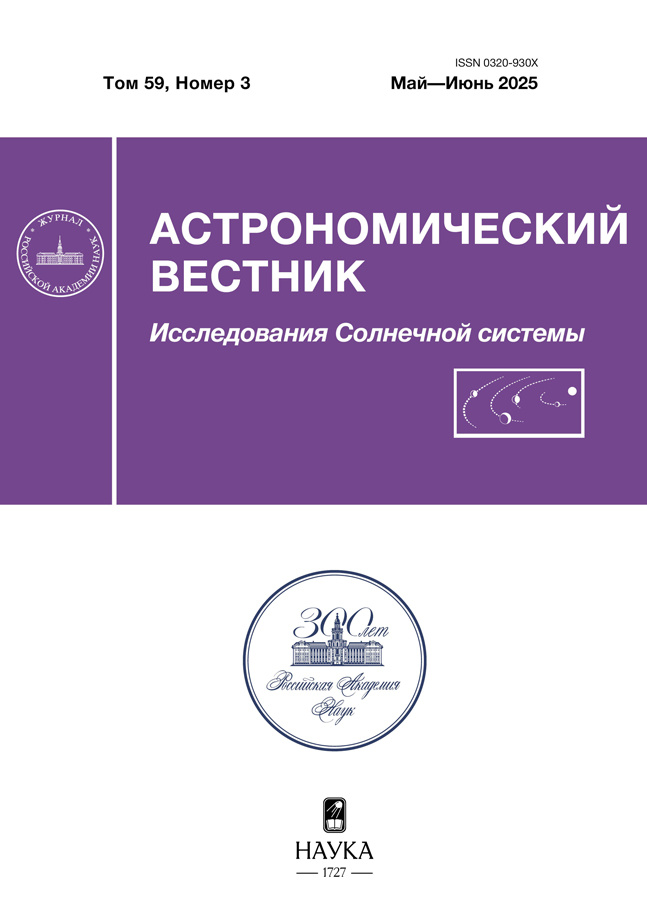Резонансные исходы взаимодействий массивных межзвездных объектов с Солнечной системой
- Authors: Микрюков Д.В.1, Шевченко И.И.1,2
-
Affiliations:
- Санкт-Петербургский государственный университет
- Институт прикладной астрономии РАН
- Issue: Vol 59, No 3 (2025): Тематический выпуск "Аналитические методы небесной механики – 2024"
- Pages: 257-262
- Section: Articles
- URL: https://jdigitaldiagnostics.com/0320-930X/article/view/689796
- DOI: https://doi.org/10.31857/S0320930X25030064
- EDN: https://elibrary.ru/KWEQCV
- ID: 689796
Cite item
Abstract
В работе изучаются последствия вероятных сближений межзвездных объектов планетных масс (свободных экзопланет) с Солнечной системой. В результате таких сближений в динамике планет могут возникать резонансы средних движений, причем вхождения в резонансы возможны лишь при избранных значениях массы межзвездного объекта и начальных условиях его движения. Выявлены наиболее существенные резонансы, которые могут возникать в результате сближений.
Full Text
About the authors
Д. В. Микрюков
Санкт-Петербургский государственный университет
Author for correspondence.
Email: d.mikryukov@spbu.ru
Russian Federation, Санкт-Петербург
И. И. Шевченко
Санкт-Петербургский государственный университет; Институт прикладной астрономии РАН
Email: d.mikryukov@spbu.ru
Russian Federation, Санкт-Петербург; Санкт-Петербург
References
- Гребеников Е.А., Митропольский Ю.А. Метод усреднения в исследованиях резонансных систем. М.: Наука, 1992. 224 с.
- Морбиделли А. Современная небесная механика. Аспекты динамики Солнечной системы. М.–Ижевск: Институт компьютерных исследований, 2014. 432 с.
- Мюррей К., Дермотт С. Динамика Солнечной системы. М.: ФИЗМАТЛИТ, 2010. 588 с.
- Субботин М.Ф. Введение в теоретическую астрономию. М.: Наука, 1968. 800 с.
- Demidova T.V., Shevchenko I.I. Spiral patterns in planetesimal circumbinary disks // Astrophys. J. 2015. V. 805. Id. 38. https://doi.org/10.1088/0004-637X/805/1/38
- Grigoryev V.V., Demidova T.V. Free fall of a Jupiter-like planet onto a protoplanetary disk // Lobachevskii J. Mathematics. 2025. V. 46. № 1. P. 95–104. https://doi.org/10.1134/S1995080224608440
- Li J., Xia Zh.J., Georgakarakos N., Yoshida F. The invasion of a free-floating planet and the number asymmetry of Jupiter Trojans // Astron. and Astrophys. 2023. V. 674. Id. A138. https://doi.org/10.1051/0004-6361/202346223
- Li J., Xia Zh.J., Lei H., Georgakarakos N., Yoshida F., Li X. Resonant amplitude distribution of the Hilda asteroids and the free-floating planet flyby scenario // Icarus. 2025. V. 425. Id. 116340. https://doi.org/10.1016/j.icarus.2024.116340
- Matsumoto Y., Ogihara M. Breaking resonant chains: Destabilization of resonant planets due to long-term mass evolution // Astrophys. J. 2020. V. 893. № 1. Id. 43. https://doi.org/10.3847/1538-4357/ab7cd7
- Mikryukov D.V., Shevchenko I.I. Rendez-vous with massive interstellar objects, as triggers of destabilization // Mon. Notic. Roy. Astron. Soc. 2024. V. 528. № 4. P. 6411–6424. https://doi.org/10.1093/mnras/stae428
- Papaloizou J.C.B. Disk-planet interactions: migration and resonances in extrasolar planetary systems // Celest. Mech. and Dyn. Astron. 2003. V. 87. P. 53–83. https://doi.org/10.1023/A:1026134209661
- Roy A., Haddow M. Energy change in a hard binary due to distant encounters // Celest. Mech. and Dyn. Astron. 2003. V. 87. P. 411–435. https://doi.org/10.1023/B:CELE.0000006767.34371.2f
- Shevchenko I.I. Dynamical Chaos in Planetary Systems. Springer Nature, 2020. 401 p.
- Valtonen M., Karttunen H. The Three-body Problem. Cambridge: Cambridge Univ. Press, 2005. 345 p.
- Wang S., Lin D.N.C. Dynamical evolution of closely packed multiple planetary systems subject to atmospheric mass loss // Astron. J. 2023. V. 165. № 4. Id. 174. https://doi.org/10.3847/1538-3881/acc070
- Zink J.K., Batygin K., Adams F.C. The great inequality and the dynamical disintegration of the outer Solar System // Astron. J. 2020. V. 160. № 5. Id. 232. https://doi.org/10.3847/1538-3881/abb8de
Supplementary files















